
La Earthcache / The Earthcache
Parce qu'il n'y a pas que le volcanisme dans la Vallée du Haut Allier...
► Contexte géologique local
L'Allier à Mosnistrol a creusé son lit sinueux entre les formations volcaniques du plateau du Devès et le socle cristallin faisant partie d'un laccolite, le granite de la Margeride.
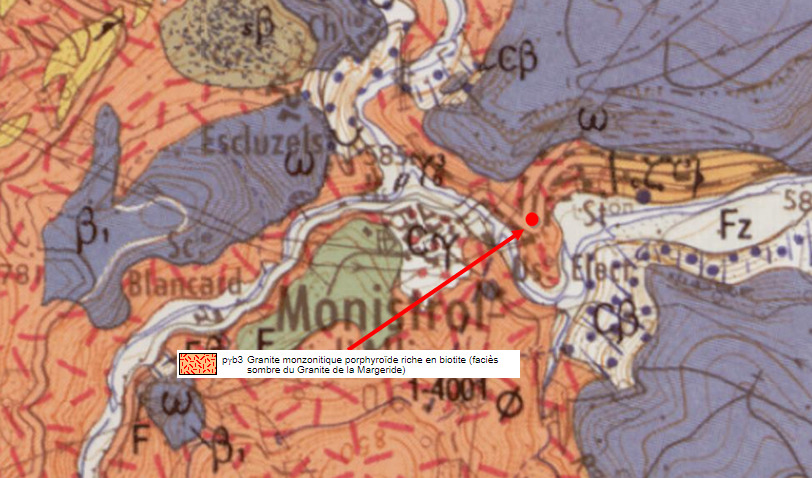
A Mosnistrol-sur-Allier, nous sommes sur la bordure orientale de ce laccolite de la Margeride.
► Rappel sur le granite, une roche QFM
Un granite présente communément une composition chimique majoritaire de 3 minéraux qui peuvent se résumer en QFM :
- Q comme Quartz : translucide parfois transparent, ce minéral est de couleur gris sans facette.
- F comme Feldspath : blanchâtre ou rose, ce minéral est opaque et souvent en macles.
- M comme Mica : souvent noir (biotite), ce minéral se présente en fines paillettes brillantes.
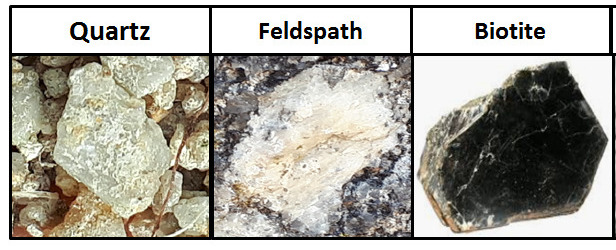
► Le laccolite de la Margeride
Ce massif de la Margeride s'étend sur 2500 km2 entre le Cantal, la Lozère et la Haute-Loire. C'est le plus important affleurement de granite en France après celui de Guéret et du Velay.
Il se présente sous la forme d'un laccolite, une intrusion de roches magmatiques parallèlement à l'encaissant (pas de lien génétique) en déformant la couche supérieure.
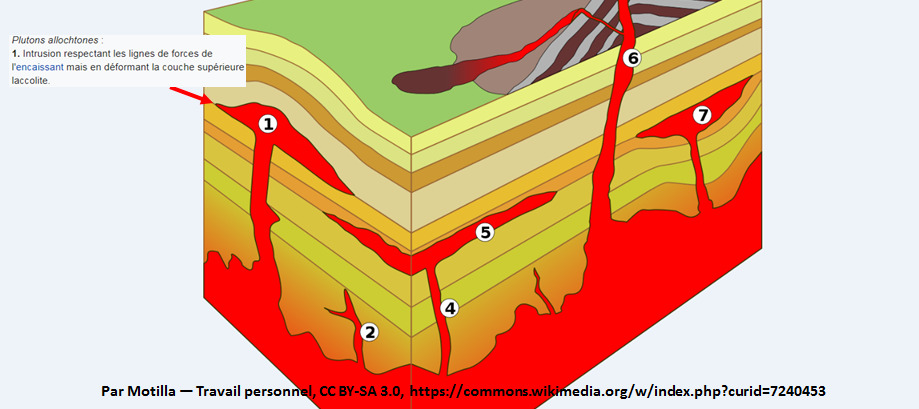
Ce laccolite constitue un témoin majeur de l'ancienne chaîne hercynienne qui traversait autrefois toute l'Europe, mise en place à la fin de la formations de la Pangée il y a 320 millions d'années.
Son magma est hyperalumineux, d'origine crustale et résulte de la fusion de vieilles formations métamorphiques visibles aux extrémités septentrionales et méridionales (gneiss).
Le granite de la Margeride varie progressivement entre 3 pôles :
- Un faciès sombre (mélanocrate), riche en biotite, présent à l'est du massif.
- Un faciès moyen (mésocrate) représentant 70% de l'affleurement.
- Un faciès clair pauvre en biotite (leucocrate) mais avec des minéraux comme de la muscovite.
Ces différents faciès se caractérisent par :
- Leur couleur qui dépend de la quantité de biotite, un minéral ferromagnésien et qu'on peut évaluer selon le Diagramme de Streckeisen.
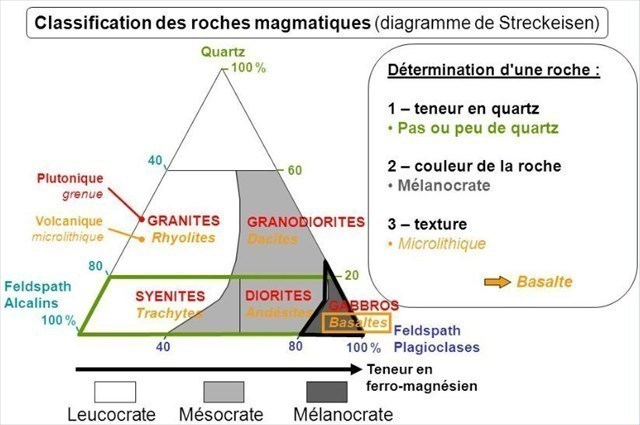
- La répartition des cristaux de feldspath potassique (orthose) : dans les faciès moyens et clairs, cet orthose se présente comme un mélange de petits cristaux dans la matrice et de mégacristaux. Pour le faciès sombre, l'orthose existe exclusivement sous la forme de mégacristaux.
► Le granite à Dents de Cheval
La granite de la Margeride est un granite porphyroïde à orthose.
Une structure est dite porphyroïde quand des cristaux ont une taille importante (centimétrique).
Ces phénocristaux d'orthose systématiquement maclés (macle de Carlsbad) peuvent atteindre 10 cm de long. Les feldspath sont orientés préférentiellement vers le haut, parfois de manière oblique.
C'est pourquoi on l'appelle le granite à dents de cheval.
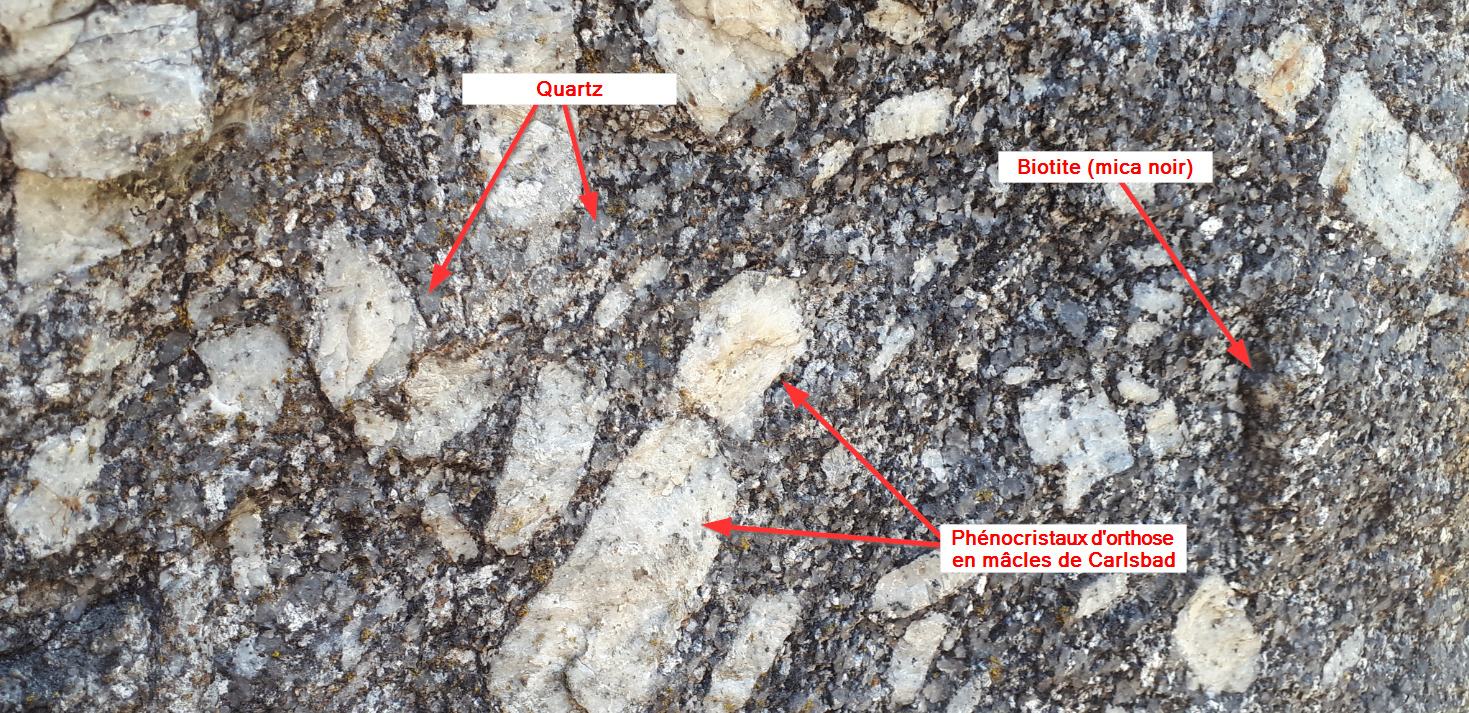
La composition du granite de la Margeride à Mosnistrol est proche d'une granodiorite : quartz = 28 % ; plagioclase = 31 % ; feldspath potassique = 23 % (dont 19 % en dents de cheval) ; biotite = 20 %.
Il est fréquent de voir des filons d'aplite (roche magmatique claire à grains très fins) se former avec le jus résiduel du magma dans des fissures.
Ce magma est enrichi en silice, appauvri en biotite et contient du mica blanc (muscovite).
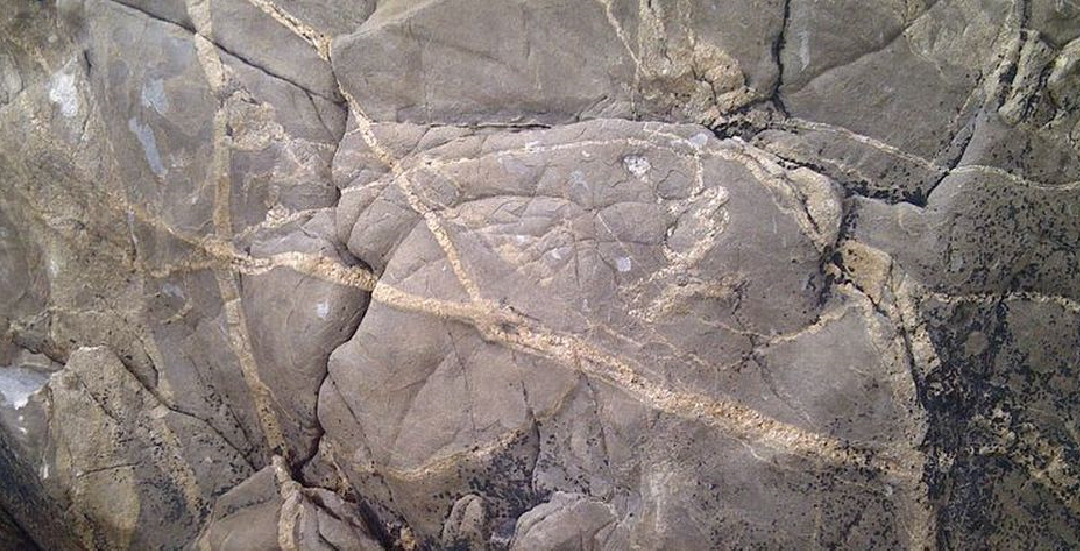
La mise à l'air libre de ces filons d'aplites entraîne l'oxydation du fer que contiennent ses minéraux, faisant passer la roche d'une couleur quasi blanche à une couleur rouille.
► Local geological context
The Allier in Mosnistrol has dug its winding bed between the volcanic formations of the Devès plateau and the crystalline base forming part of a laccolite, the granite of the Margeride.
At Mosnistrol-sur-Allier, we are on the eastern edge of this laccolite in the Margeride.
Because there is not only volcanism in the Haut Allier Valley ...
► Reminder on granite, a QFM rock
A granite commonly has a majority chemical composition of 3 minerals which can be summarized in QFM:
- Q for Quartz: translucent sometimes transparent, this mineral is gray without facet.
- F like Feldspar: whitish or pink, this mineral is opaque and often twinned.
- M like Mica: often black (biotite), this mineral comes in fine shiny glitter.
► The laccolite of Margeride
This Margeride massif stretches over 2500 km2 between Cantal, Lozère and Haute-Loire. It is the largest outcrop of granite in France after that of Guéret and Velay. It appears in the form of a laccolite, an intrusion of magmatic rocks parallel to the host (no genetic link) by deforming the upper layer.
This laccolite is a major witness to the ancient Hercynian chain that once crossed all of Europe, set up at the end of the formation of Pangea 320 million years ago.
Its magma is hyperaluminous, of crustal origin and results from the fusion of old metamorphic formations visible at the northern and southern ends (gneiss).
The Margeride granite gradually varies between 3 poles:
- A dark (melanocratic) facies, rich in biotite, present to the east of the massif.
- An average facies (mesocrates) representing 70% of the outcrop.
- A clear facies poor in biotite (leucocrates) but with minerals like muscovite.
These different facies are characterized by:
- Their color which depends on the quantity of biotite, a ferromagnesian mineral and which can be evaluated according to the Streckeisen Diagram.
- The distribution of potassium feldspar crystals (orthosis): in the medium and clear facies, this orthosis appears as a mixture of small crystals in the matrix and mega crystals. For the dark facies, orthosis exists exclusively in the form of megacrystals.
► Horse Tooth Granite
The Margeride granite is a porphyroid granite with orthosis.
A structure is said to be porphyroid when crystals have a large size (centimeter).
These systematically twinned orthosis phenocrysts (Carlsbad twin) can reach 10 cm in length. The feldspar are preferably oriented upwards, sometimes obliquely.
This is why it is called horse tooth granite.
The composition of the Margeride granite at Mosnistrol is close to a granodiorite: quartz = 28%; plagioclase = 31%; potassium feldspar = 23% (including 19% in horse teeth); biotite = 20%.
It is common to see aplite veins (clear magmatic rock with very fine grains) forming with the residual magma juice in cracks.
This magma is enriched in silica, depleted in biotite and contains white mica (muscovite).
The venting of these veins of aplites leads to the oxidation of the iron contained in its minerals, causing the rock to change from an almost white color to a rust color.
► Sources bibliographiques / Bibliographical sources
Les Questions / The Questions
La lecture attentive du descriptif de la cache, ainsi qu'une observation des éléments de terrain et un peu de déduction sont normalement suffisants pour répondre aux questions de cette EarthCache.
A careful reading of the description of the cache, as well as observation of terrain features and some deduction is usually sufficient to answer questions of this EarthCache.
Questions pour valider :"Granite de la Margeride à Mosnistrol-sur-Allier"
Questions to validate: "Granite of Margeride in Mosnistrol-sur-Allier"
Point 1 : N 44° 58.096 E 003° 38.885
Vous voici devant un affleurement de roche ou est fixé un panneau parlant de la bête du Gévaudan. Observez cette roche autour du panneau.
Here you are in front of an outcrop of rock where is fixed a sign speaking of the beast of Gévaudan. Observe this rock around the panel.
- Question 1 : Quelle est la couleur de la matrice de la roche ? D'après le diagramme de Steincken, que traduit cette teinte ? En prenant les minéraux QFM, quel minéral appartient à cette famille ?
- Question 1 : What is the color of the rock matrix? According to Steincken's diagram, what does this shade translate? By taking QFM minerals, which mineral belongs to this family?
- Question 2 : Décrivez les plus gros cristaux et donnez leur nature. Qualifiez les selon leur taille et leur forme. Voyez-vous ce même type de cristal dans la matrice sous la forme de tous petits cristaux ?
- Question 2 : Describe the largest crystals and give their nature. Qualify them according to their size and shape. Do you see this same type of crystal in the matrix in the form of very small crystals?
- Question 3 : Quelle est l'orientation générale que prend les plus gros cristaux ? Cela est-il cohérent avec le surnom de cette roche ?
- Question 2 : What is the general orientation of the larger crystals? Is this consistent with the nickname of this rock?
- Question 4 : Des 3 premiers questions déduisez le faciès du laccolite à Monistrol sur Loire.
- Question 4 : From the first 3 questions deduce the facies of the laccolite at Monistrol sur Loire.
Point 2 : N 44° 58.079 E 003° 38.879
Poursuivez le long de l'affleurement jusqu'au point suivant (photo WP2).
Continue along the outcrop to the next point (photo WP2).
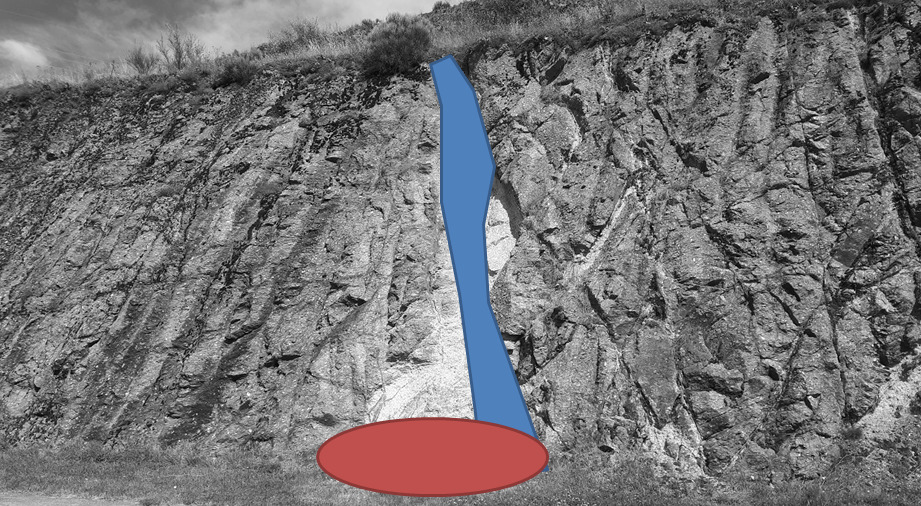
- Question 5 : Que voyez-vous sous la zone bleue ? Comme s'appelle cette structure et comme se met-elle en place ?
- Question 5 : What do you see under the blue area? What is this structure called and how is it setting up?
- Question 6 : Quelles est sa couleur et l'origine de cette coloration ?
- Question 6 : What is its color and the origin of this coloring?
- Question 7 : Sous la zone rouge, vous pouvez trouver du granite altéré en arène. Quels cristaux y retrouvez-vous ? Déduisez-en le minéral qui a été altéré, déstructurant la roche en arène.
- Question 7 : Under the red zone, you can find granite altered in arena. What crystals can you find there? Deduct the mineral that has been altered, destroying the rock in an arena.
Point 3 : N 44° 58.071 E 003° 38.854
- Question 8 : Prenez une photo de vous ou d'un élément vous identifiant avec la Vallée du Haut Allier depuis le WP3 en arrière-plan.
Cette photo devra au choix nous être transmise avec les réponses ou être ajoutée à votre log.
-Question 8 : Take a photo of yourself or an item identifying yourself with the Haut Allier Valley from the WP3 in the background.
This photo must either be sent to us with the answers or added to your log.
Vous pouvez vous loguer sans attendre notre confirmation,
mais vous devez nous envoyer les réponses en même temps soit par mail via notre profil (
fafahakkai), soit via la messagerie geocaching.com (Message Center).
S'il y a des problèmes avec vos réponses nous vous en ferons part.
Les logs enregistrés sans réponses et la photo seront supprimés.
You can log this cache without waiting for our confirmation, but you must send us the answers at the same time, by e-mail via our profile (fafahakkai) or by the system of Message Center of geocaching.com.
If there is a problem with your answers we will notify you. The logs recorded without answers and the photo will be deleted.
Rappel concernant les « Earthcaches »: Il n'y a pas de conteneur à rechercher ni de logbook à renseigner. Il suffit de se rendre sur les lieux, de répondre aux questions ci-dessus et de nous renvoyer les réponses.
Reminder concerning "Earthcaches": there is neither a container to look for nor a logbook to sign. One need only go to the location, answer to the differents questions and send us the answers.